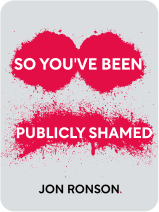

This article is an excerpt from the Shortform book guide to "So You've Been Publicly Shamed" by Jon Ronson. Shortform has the world's best summaries and analyses of books you should be reading.
Like this article? Sign up for a free trial here .
What do we know of the psychology of shame? What do people tend to be ashamed of? Do you think shameful feelings are grounded in reality or are they purely subjective?
Although shame is a subjective emotion, the psychology of shame has more to do with other people than with ourselves because shame stems from the fear of judgment. Most people tend to harbor shameful feelings about things that wouldn’t be deemed scandalous by others. That said, there are also some things that would be deemed shameful by society in general.
In this article, we’ll take a closer look at shame psychology in terms of its causes and consequences.
The Psychology of Shame: Causes and Consequences
According to psychiatrist James Gilligan, shame isn’t a feeling, it’s an absence of feeling. Initially, shame might feel like pain, but long-term, it becomes more like numbness or deadness. Shame psychology identifies some of the key causes of shame.
Causes of Shame: Vulnerabilities and Societal Expectations
In modern times, the things people are most ashamed of tend to be personal secrets that aren’t objectively very scandalous or that would seem unimportant to others. For example, Melissa’s salary is $550,000 a year and she’s ashamed that she makes so much, and Jim is ashamed that he smokes an ounce of marijuana every three weeks. When they both revealed these secrets at an honesty workshop, none of the other participants cared.
However, there are some things that society generally labels as shameful. For men, this includes exercising white privilege, committing a professional faux pas like plagiarism, or losing their jobs and being unemployed. For women, this additionally includes sex scandals. (Sex scandals used to be shameful for men back in the 1800s and 1900s, but these days, people consider other transgressions worse.)
● For example, when the client list of Alexis Wright’s one-woman brothel was released, it contained the names of sixty-eight men and one woman. Then men faced consequences—for example, pastor James Andrew Ferreira was fired and his wife left him—but didn’t experience shaming. The woman, on the other hand, did—even the men who had been involved in the scandal made jokes about her.
Consequences of Shame: Violence
Most violence isn’t motivated by revenge or self-defense—it’s motivated by shame. Violence is an effective way to gain instant self-esteem—threatening someone with a gun tends to make them treat you with respect. This self-esteem and respect help to fill the void caused by shame.
The work of two scientists demonstrates the connection between shame and violence:
Case Study 1—James Gilligan: Prison Violence
In the 1970s, prisons and mental hospitals in Massachusetts were experiencing a period of violence that included frequent suicides, murders, and other dangerous activities like riots and fire-setting. The Department of Corrections was ordered to bring in investigative psychiatrists to sort things out and James Gilligan was invited to take charge of the project. He originally wasn’t very enthusiastic—he expected that the most violent people would be unredeemable psychopaths.
However, that wasn’t what he found at all. In fact, Gilligan discovered that all of the violent inmates had experienced severe shaming during their lives, such as being thrown out of windows, raped, or set on fire. This extreme shame drove them to shut down emotionally. This numbness was so painful that they tried hurting themselves or others to trigger feelings, whether physical or emotional.
Being in prison only added to their shame—officers and guards treated the inmates badly and humiliated them. For example, sometimes officers lied to prisoners about them having a visitor. Prisoners would get excited by this news because visitors were rare and then be disappointed when they found out it was just a joke. The officers thought this kind of behavior would ensure obedience, but it just made people more prone to violence.
Once Gilligan realized what the real cause of the violence was, he tried to improve the situation. In the 1980s, he experimented with therapeutic communities. In these communities, everyone had to treat the prisoners with respect and give them a shame-free place to talk about themselves and what they wanted. After some time, some of the prison workers became jealous of these sessions, and Gilligan got them some psychiatric treatment too. This helped them behave more civilly to the prisoners, and violence decreased.
In 1991, Gilligan tried to additionally use education to deshame inmates and asked Harvard lecturers to teach free classes at prisons. When William Weld was elected as governor, however, he shut the program down because he thought that people who couldn’t afford college would start committing crimes to get free education.
A few of Gilligan’s therapeutic communities still exist today and are still effective at deshaming inmates and reducing violence. For example, Raquel, like the prisoners in Gilligan’s original study, experienced shame as a child—growing up, she was sexually abused. This made her hard on her own children and her son eventually accused her of child abuse. Eventually, she was charged with attempted murder because she threw a knife at her son.
The community’s head understood that shame played a huge role in Raquel’s case and convinced the prosecutors that Raquel was part of an “abuse cycle.” Raquel wasn’t allowed to contact her children for five years, but her sentence was four months instead of twenty years. She was also offered a job at her halfway house, which further boosted her self-esteem.
Case Study 2—David Buss: Murderous Fantasies
Evolutionary psychology professor David Buss also discovered that shame is a powerful motivator for violence during an experiment about people’s murder fantasies in the early 2000s. Buss asked 5,000 people if they’d ever thought about killing someone and the numbers blew him away—84% of men and 91% of women had experienced at least one vivid fantasy of murdering someone. For example, one man imagined hiring someone to tamper with his boss’s brakes, and a boy visualized breaking a bully’s legs and dripping acid on him.
Almost all of the fantasy victims had shamed the fantasizers. For example, the person who imagined killing his boss had been humiliated by the boss and made to feel like a loser. The boy who fantasized about breaking legs and dripping acid had been laughed at by the bully and his friends after the bully dropped books on him.
Most people who fantasize about hurting people don’t actually go out and do it, but Buss’s work shows that shame and violence are linked and this affects everyone, regardless of their self-control levels.

———End of Preview———
Like what you just read? Read the rest of the world's best book summary and analysis of Jon Ronson's "So You've Been Publicly Shamed" at Shortform .
Here's what you'll find in our full So You've Been Publicly Shamed summary :
- How public shaming can ruin people's lives
- Why public shaming isn't just a way to get corporations to do the "right thing"
- 6 strategies you can use if you're a victim of public shaming






